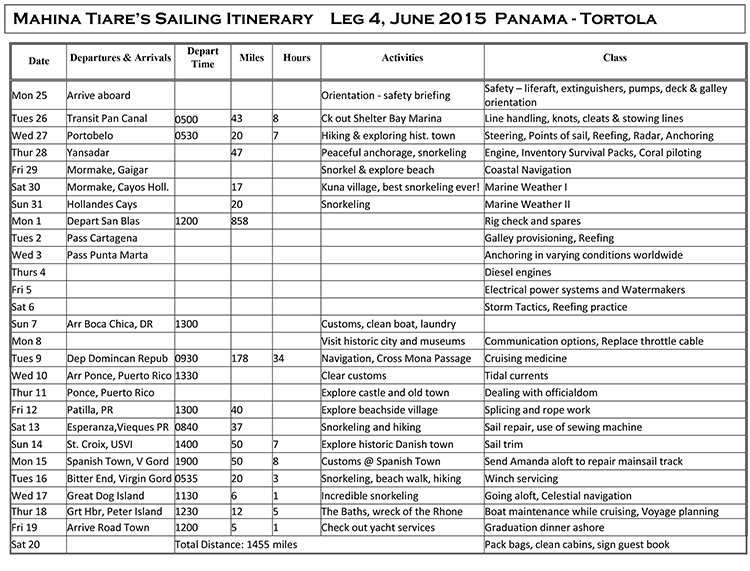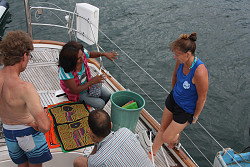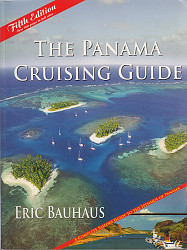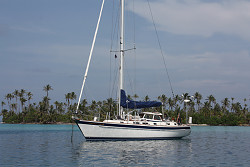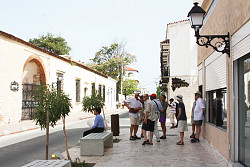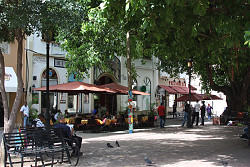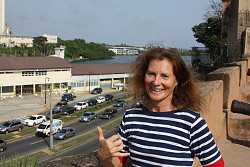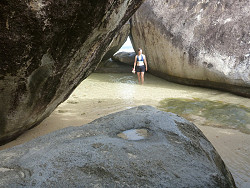Leg 4 – 2015, Update 1
May 26, 2015, 1500 hrs, 9.14 N, 79.55 W, Log: 185,107 miles
Baro: 1008.7, Cabin Temp: 87 F, Cockpit: 89 F, Sea Water: 85.1F (Gatun Lake – freshwater)
Motoring at 7.5 kts with 14 kts NW headwinds
Inside the Panama Canal – approaching Gatun Locks
WE ADMIT IT! WE LOVE THE PANAMA CANAL AND CONSIDER OURSELVES “CANAL JUNKIES!!!”
We’re ¾ the way through our Panama Canal transit and it has been an exciting and excellent transit so far. Currently Guillermo, our Pilot Advisor, has asked for “best possible speed” to see if we can reach Gatun Lock, the final lock, before we enter Limon Bay and the Caribbean Sea. If we’re quick enough, he has permission from the lockmaster for us to slip into the lock before a blue and white PANAMAX car carrier that is currently raising anchor in Gatun Lake ready for its scheduled lock down. Upon entering the chamber first, we’ll be tying center chamber by ourselves with the huge car carrier behind. If we don’t make enough speed we’ll be spending the night side-tied to a huge mooring buoy in the lake, locking down the next day.
 Leg 4-15 crew:Derek, canal pilot advisor, Jennifer, Pierre, Geir, Peter, Momi, and linehandler Blondie and Amanda in front. |
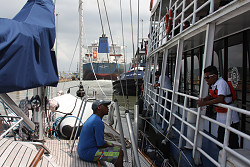 Side-tied to local tour boat in Miraflores Loc |
To show you how much we love the canal, I went with our Leg 3 crew to the first ever public viewing of the new, not-yet-completed giant-sized third lock (absolutely huge!) and for a holiday we spent a night in the Country Suites Hotel on the banks of the Pacific Balboa canal entrance where we could watch a steady parade of ships day and night.
Our current crew all took the time to go to the Miraflores Locks Visitor Center to watch canal lock operation and generally learn how the locks work.
We had our normal safety orientation Sunday from 4-6 pm, collecting passports and filling out tourist visa applications.
 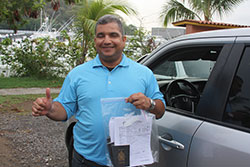 |
First thing Monday morning Elias Castillo collected our passports, got our visas and zarpe (outbound clearance) returning at noon Monday when our crew joined us. Tina McBride, (www.panamacanaltransits.com, tinamcbride@hotmail.com) our excellent canal agent and long-time friend came aboard at noon to meet our crew and inspect her rental lines (4 lines, each 125′ long with 18″ eye splices).
After expedition orientation Monday afternoon we readied and re-arranged all of our ten docklines (the surge in La Playita Marina had been incredible, so we kept adding more lines!) and tied on our 12 fender tires ready for our pre-dawn departure. After refreshing showers we then hiked a mile or so out to the snazzy Flamenco Marina where we enjoyed an excellent Lebanese dinner at a new restaurant chain Beirut.
This morning Blondie, the professional line handler supplied by Tina McBride arrived at 0530 and by 0600 we were underway and shortly after we were on standby waiting for our pilot advisor.
Leg 4 – 2015, Update 2
June 24, 2015, 1500 hrs, 18.32 N, 64.36 W, Log: 186,560 miles
Baro: 1022.2, Cabin Temp: 87 F, Cockpit: 88 F, Sea Water: 84.6F
At anchor, Peter Island, 4 miles S of Road Town, Tortola, British Virgin Islands
Thankfully our full steam ahead for Gatun Lock proved to be adequate and we successfully locked down ahead of the car carrier.
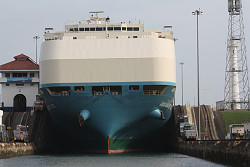 Mahina Tiare entering Gatun locks ahead of Panamax car carrier – image taken from the canal web cam |
 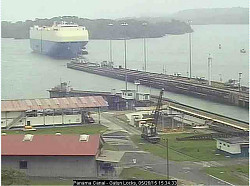 Panamax car carrier towering behind Mahina Tiare in Gatun Lock |
Our canal transit ended with a canal launch picking up Guillermo, our pilot advisor off Colon and then us high-tailing to arrive at Shelter Bay Marina, (www.shelterbaymarina.com) three miles away just before dark. Marina manager John Halley kindly met us, directing us to a slip, taking our lines and welcoming us to Shelter Bay. Minutes later our crew helped Blondie cart the transit dock lines and tires ashore and then headed ashore for showers, cold drinks and dinner. What a blur the day had been and with no scrapes or bruises we were ready to set sail for the San Blas Islands in the morning.
Actually, we set sail for Portobelo, a wild-west kind of end-of-the-road town which had been a major Spanish port transporting silver and gold and was heavily fortified against pirate attacks although the notorious Henry Morgan managed to successfully sack the town.
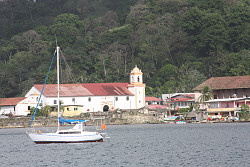 Portobelo’s historic cathedral and counting house |
We were surprised to find nearly 50 vessels including many cruising boats apparently left anchored unattended while owners flew back to Europe or North America for the hurricane season and even a rusty old ferry.
Scanning the shoreline for a safe place to leave our dinghy while we explored ashore, we saw several dinghies tied up at house with a “Casa Vela” (sail house) sign. The German owners were sailmakers and sold beer and said we were welcome to leave
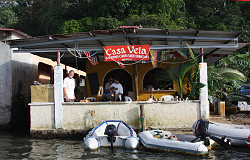 Casa Vela; cruiser’s hangout in Portobelo |
our dinghy there. Ashore we found several new hostels, and met a guy from one who said there was a regular business of taking backpackers on sailboats from Portobelo to Cartagena, Columbia and vice versa, a distance of about 150 miles with only very expensive air flights.
Early the next morning we set sail on a 42 mile passage direct to the San Blas Islands. Our navigator for the day was busy as we wove our way through some narrow and shallow coral and sand channels to Yansadar, a favorite anchorage off an uninhabited islet and in no time most of our crew were in the water exploring and helping sponge the bottom. For the first time since Oregon we had rain and overcast which was a respite from the hot tropical sun.
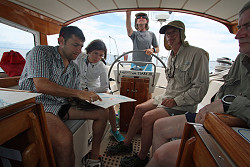 Crew navigating through narrow, shallow channels to Yansadar |
Shortly after we had anchored, two Kuna men pulled up in a skiff, but instead of offering us molas (traditional embroidered applique panels) to purchase, they had potatoes, onions, broccoli, frozen chicken and many types of local fruit plus beer and Coke which they had purchased in Panama City, transported across the country and were now selling to cruisers. Very industrious and we were pleased to purchase some more fruit and veg!
Friday we briefly stopped off Mormake Tupu, telling the Restrepo family we would return in the morning to visit the village and deliver school books and supplies to the headmaster. Venancio, the oldest son of this family of artists was away, but shortly after we anchored at Gaigar, a protected fairly remote mangrove anchorage a few miles away, Venancio, returning from a visit to Panama City came aboard and said that he would speak to the sila, or village chief about our visit the following morning.
Shortly after, Lisa Harris the most famous mola-maker (and transvestite) came by to show us her latest molas, explaining the designs and symbols.
Saturday morning we anchored off Mormake Tupu islet and went ashore at the Restrepo family dock. We’ve visited this family four times in the past 15 years, having first been introduced by other cruisers. As in previous visits, we brought reading glasses (thank you Charles & TC), which are much sought-after by the women who sew and sell molas to cruisers as the one source of cash income in their society. Jennifer and Pierre had also generously purchased a substantial amount of school reading glasses in Panama along with school supplies which they were able to donate to the school headmaster along with three boxes of Spanish Scholastic Books we had earlier purchased.
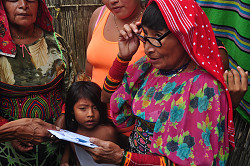 Kuna woman trying on reading glasses donated by Jennifer and Pierre |
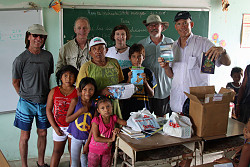 Delivering Scholastic Books and school supplies |
That afternoon we headed to a new anchorage on the far NW corner of Western Holandes Cays, in a cove between two outer barrier islands, each having only one family of residents. Here we found the most vibrant and healthy coral reef and fish population we have ever seen ANYWHERE! Many, many different types of vibrant coral, dozens of species of fish and good visibility. The location; 9.35N, 78.46W is one we have marked on our chart and circled on Eric Bauhaus’ recently-updated and expanded excellent Panama Cruising Guide.
First thing Sunday morning most of our crew were snorkeling again, mesmerized by the beauty. After class we dinghied ashore, hiking around the island meeting the single family living there.
 Jennifer & Pierre on Western Holandes Cay beach. |
That afternoon we sailed to an anchorage nicknamed “Swimming Pool” by cruisers, the most famous in the San Blas. Surrounded by palm-tree clad islets, a few of which have a Kuna family or two living on them, cruisers have congregated here for many years. I had expected to find 15-20 cruising boats, but there were only five, and the crews of three of the boats said they had been based there from 5-17 years, only occasionally returning to Shelter Bay Marina for supplies.
Monday morning while we were covering our weather class, an older Kuna man in a dugout paddled up and asked if he could trade us fruit for charging his cell phone. He returned just before we set sail with a few mangoes and avocados and asked if we could also full his water jug.
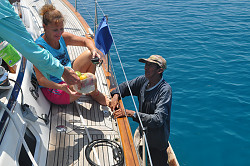 Returning a charged cell phone in exchange for fruit |
That afternoon we sailed to At 1300 on Monday, June 1st we set sail, slightly unsure of our destination. We were considering stopping at a new IGY marina in Punta Marta, west of Cartagena and Baranquilla, Columbia, but not as far along as the Venezuelan border, but on emailing the marina’s ship’s agent they said clearing in and out of Columbia required a minimum of 2-3 days, too long for our liking.
Calm seas and favorable N winds prevailed as we sailed whenever possible and motorsailed when necessary staying 20-50 miles offshore to avoid headwinds and contrary currents. Tuesday we passed several ships drifting off Cartagena, waiting for dock space and Wednesday we passed Baranquilla where the sea turned the color of mud and trees and small bits of islands drifted by. At times the headwinds increased to 20-25 kts and we would reef down the main, motorsailing and tacking to avoid rougher conditions offshore.
Thursday morning we held an inshore tack until we were in calm waters just a few miles from shore and an oil platform in the lee of Punta Vela. While crew ghosted MT along, I changed engine oil and watermaker pre-filter and we transferred our deck and lazarette fuel jugs into the main tank. That done, we tacked to sail NE toward Boca Chica, Dominican Republic. Friday was our roughest day and with winds of 20-25, gusting 35 we had all three reefs in the main and four in the genoa. We concentrated on keeping boat speed down to 5-6 kts so the motion below would be tolerable, but overall sea conditions weren’t bad considering we were going against the trade winds. The forecasted SE winds that would have allowed us to ease sheets and go on a close reach only materialized the last night, but Saturday brought much nicer sea conditions and Amanda was able to teach galley orientation and provisioning.
By 1100 Sunday our crew spotted skyscrapers ashore and by 1300 we had passed the capital, Santo Domingo and were winding our way into Marina ZarPar, a joint venture between an American and local guy. Just as we were approaching the dock, our throttle cable broke and so we had Jennifer in the engine room to increase engine revs while docking.
 First view of Marina ZarPar |
Our first impression of the DR was that of exuberant total chaos! 50′ sportfishing boats would zoom by just a few feet off our beam (we were moored on the face of a long marina dock) with music blasting and people dancing on the foredeck. Yep, it’s the weekend…time to party!
I’d learned of Marina ZarPar through Seven Seas Cruising Association bulletin (www.ssca.org) and from www.noonsite.com and had found Yolanda Renal, yrenal@marinazarpar.com, marina office manager and dockmaster Rigo Pichardo, rpichardo@marinazarpar.com to be most helpful both by email and now in person. I’d also read that DR customs have been working at overcoming their previous bad reputation and we had no difficulty clearing in with customs, immigration and security officials, several of whom had offices in the marina.
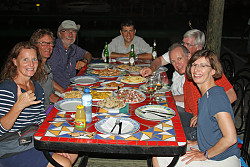 Tasty crew dinner at Teresita restaurant in the marina |
We were pleased to find huge commercial self-service washers and dryers, a friendly little restaurant, free w-fi and showers in the marina.
Monday was a very busy day. Amanda and I went for a long run along the beach and toward the small local resort town of Boca Chica, then after making breakfast took a taxi to an excellent new supermarket a couple miles away. Rigo helped arrange taxis and after lunch we all headed 12 miles away to Santo Domingo, first to a large marine store where unbelievably, I found the exact throttle cable we needed, then to the “old colonial city” where we met Felix, an excellent professionally-trained and licensed guide who guided us on a fascinating walking tour of the many restored historic buildings, most of which are 500 years old. Santo Domingo is very proud of the fact that this is where Columbus landed, and site of the first church in all of the New World.
Maiden won the Whitbread qualifying race from Cadiz, Spain to Santo Domingo on handicap. Their win caused such an uproar with the maxi yachts that they protested to the Whitbread Race organizers to change the handicapping rating for the round the world race so that there was no chance of a small boat taking a prize.
Felix recommended the colonial Mimosa Restaurant for dinner which was very enjoyable dining experience in the tranquil bricked mango tree courtyard. Once back aboard MT, Amanda and I managed to change out the throttle cable late into the evening without having to dismantle the shifter mechanism – a cause for celebration!
Early Tuesday morning immigration, customs, the navy and security service, complete with a German shepherd drug sniffing dog came aboard to clear us out. Rigo had earlier explained that the DR has a deal with the US that all boats clearing out and headed for Puerto Rico must be checked by the sniffer dog. Rather bizarre and the dog REALLY did not want to go aboard, but we had no problems, other than having to quickly remove all traces of our pancake breakfast as it was confusing the dog, and were soon on our way.
 Customs drug sniffing dog searching for pancakes |
By hugging the S coast of the DR we had very mellow motorsailing conditions and our plan was to cross the often tempestuous Mona Passage at night when the trades are generally considerably lighter. Sure enough, we had only 8-11 kts for the Mona Passage and by 1330 on Wednesday we’d moored to the new Ponce US Customs & Border Patrol dock next to Caribbean Images “marina”. It took several hours to clear customs but eventually we were given the all clear and happily moved to the new “marina” which actually turned out to be a small dock without any services other than water, but perfectly ok.
Thursday our crew took off to explore Ponce town and an interesting castle while Amanda and I rented a car for a 2 hour drive to Fajardo’s West Marine and Costco enroute. Puerto Rico seemed prosperous, well-organized and clean after the Dominican Republic and Panama.
Friday morning we topped up fuel at Ponce Yacht and Fishing Club with the cheapest diesel we’ve seen in decades: US$2.47 per gallon before motorsailing to Patilla, a coastal village for the night. Saturday morning we had a 0330 start for the channel crossing to Puerto Rico’s Vieques Is, where we enjoyed visiting Esperanza, a small beach and fishing village. Sunday we got another 0330 start, this time for the choppy channel crossing to St. Croix, in the US Virgin Islands. We moored at St. Croix Marine and toured historic Christiansted that afternoon.
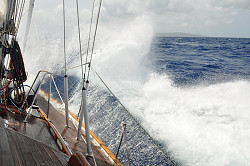 Charging to windward toward St. Croix |
Monday morning I cleared us out of the USVI, (US Customs Border Control office is conveniently located adjacent to St. Croix Marine) and Amanda went aloft to check the mainsail track and at 1130 we set sail on a glorious reach for the British Virgin Islands. As this was our first serious off-the-wind sailing, our crew were in a celebratory mood! Geir had recently completed two instructional cruises of the BVI and pointed out several of his favorite snorkeling and anchoring spots as we sailed past Norman and Peter Islands. We arrived at Spanish Town, Virgin Gorda at 1900, just before dark, finding many available berths in the well-organized and impressive marina complex.
Early the following morning we cleared customs near the marina then set sail for Gorda Sound, the famous area at the north end of Virgin Gorda Island. Derek, an excellent swimmer and diver and I surprised the rest of the crew with a surprise man-overboard situation where Derek “fell” overboard and I demonstrated our version of the Quick-Stop Lifesling rescue. Once we reached Gorda Sound, each crew member executed the same maneuver.
We picked up a mooring ball in front of the Bitter End Yacht Club and enjoyed walks along the boardwalk that afternoon and cold drinks overlooking the protected harbor with Saba Rock and Richard Branson’s Necker Island visible. Wednesday morning we all headed long out on long hikes to the summit and along the ridge of Virgin Gorda with stunning vistas before doing a photo shoot of MT in front of the Bitter End YC and setting sail.
 Fabulous view of Bitter End Yacht Club and Gorda Sound, Virgin Gorda Island |
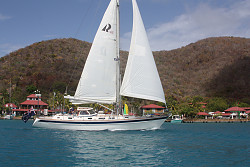 MT sailing past Bitter End YC |
 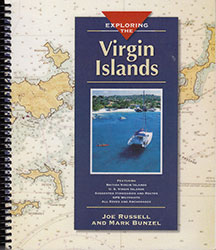 We found Mark Bunzel & Joe Russell’s “Exploring the Virgin Island Islands” superbly helpful |
We had planned to sail south, nearly to The Baths, but with daylight fading, Geir suggested picking up a mooring at Great Dog Island, where he’d snorkeled. It was perfect, there weren’t any boats, the snorkeling was incredible, and when a passing rain squall really tipped on us, goats clamored down the steep rocky cliff to drinking water that had collected in small rock pools. Early Thursday morning we sailed to The Baths, the remarkable jumble of giant granite boulders found on nearly every chartering ad or brochure for the BVI’s. We arrived before any charter boats, took a mooring, swam ashore and had a great time hiking from one beach to the next.
Shortly we set sail for Salt Island, practicing taking sextant shots enroute to where Geir recommended we pick up a mooring and snorkel over the wreck of the Royal Mail Ship Rhone, as he had done earlier this year. We were surprised to see how huge (310′ with 300 passenger cabins) and how accessible (stern is in only 20′ depths) the well-preserved 1867 wreck is.
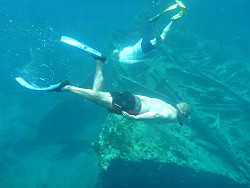 Geir and Peter exploring the Rhone wreck |
We had a great sail to Great Harbor, Peter Island where we took a mooring and after covering boat maintenance, splicing and going aloft we headed ashore to check out the
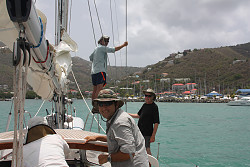 Arriving in Road Town, Tortola |
small bar and restaurant. Friday morning we covered passage planning, using our Panama to Australia PowerPoint show as an example. As Momi and family will be departing within weeks of this passage and as several other expedition members are planning similar voyages, it was keenly received. Soon after we set sail on the four mile passage to Road Town, capital of the BVI and home to Village Cay Marina & Hotel, our destination. Once docked, we enjoyed lunch before Amanda and I went to sign crew off at Immigration.
That night for our graduation dinner crew chose Dove, an upscale Asian/French restaurant located in a quaint Caribbean, and we were delighted with an exquisite dinner. Saturday morning it was a final round up on our teaching after cleaning and packing and then on to new adventures!
Here’s our hearty Leg 4 crew:
Peter, 61
I am an academic anesthesiologist working at the U of W Seattle and am originally from Scotland. My earliest boating memories were of exploring the little islands in Loch Lomond in a dinghy from our motor boat. By the time I was seven I was sailing and have not looked back spending every summer sailing around the Hebrides with my parents. I moved to the USA in 1980 and eventually to Seattle where I introduced my sons to sailing lessons at an early age. I have owned a few boats but my longest term dream has been ocean voyaging and my present boat is a Najad 355 which came without instructions– so I joined John and Amanda to learn how to use her for ocean cruising. I plan to sail her or perhaps another yacht with my family and friends when I retire, which will be soon!
Momi, 43
I’m from Israel and me and my family “invest” all our time and money traveling to new places around the world, sometimes also climbing high mountains. Usually we travel for a few weeks, and from time to time we leave for longer trips. On our last long (one year) trip, we (me, my wife and 1.5 yr old) traveled overland to Russia, Mongolia, China, NZ and finished in Australia. Now one week after this expedition ends, I will be leaving with my wife and three boys aboard our Lagoon 380 catamaran for two years of adventure, sailing from Greece to the South Pacific.
Derek, 59
I’m a contractor, furniture and cabinet maker in San Francisco. In my late teens I sailed on a schooner off the coast of Maine and the experience never left me. Since then I have had the dream of getting a boat and sailing around the world. Besides being on the ocean, I also have a passion for freediving and underwater photography. My plans are to fulfill my dream and sail to the South Pacific and New Zealand.
Geir, 62
Originally from Norway, but living in Vancouver, Canada
I have dreamt about blue water sailing for most of my life, but have been a power boater for the past 30 years, only starting taking sailing lessons two years ago. I joined this expedition (and chose a difficult one!) to see if I have what it takes to sail offshore. This has been a great experience that has encouraged me to pursue my dream.
Jennifer, 52
With my husband Pierre, I own a Bongers 39, a South African-built sloop which we are considering sailing from Vancouver to Mexico and the South Pacific. Two years ago I crewed with two girlfriends on their Morgan 38 from the Galapagos to the Marquesas. It was a very easy downwind passage and I chose this leg in order to experience and build confidence in heavier upwind sailing conditions. It’s been a fantastic experience and a long beat to windward is no longer a scary thought!
Pierre, 56
I was introduced sailing in Quebec in 1980 and crewed in local races aboard a Catalina 27 in Victoria, Canada in the late 80’s. We bought our current boat in 2003 and lived aboard in Vancouver for five years. We now enjoy exploring B.C.’s coast and came on this expedition to help decide if we want to get ready to cruise the Pacific.
Leg 4 Itinerary
